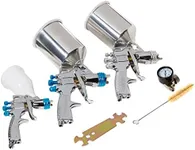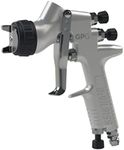Buying Guide for the Best Automotive Paint Guns
Choosing the right automotive paint gun is essential for achieving a smooth, professional finish on your vehicle. The right tool can make painting easier, more efficient, and help you avoid common issues like uneven coverage or excessive overspray. When selecting a paint gun, it's important to understand the key specifications and how they relate to your specific needs, such as the type of project, your experience level, and the kind of paint you plan to use.Type of Paint Gun (HVLP vs. LVLP vs. Conventional)The type of paint gun refers to how the gun atomizes and delivers paint. HVLP (High Volume Low Pressure) guns use a high volume of air at low pressure, resulting in less overspray and more efficient paint transfer, making them popular for automotive work. LVLP (Low Volume Low Pressure) guns use even less air, which can be helpful if you have a smaller air compressor. Conventional guns use higher pressure and can provide a finer finish but tend to waste more paint. If you are working in a home garage or want to minimize paint waste, HVLP is often the best choice. If you have a limited air supply, consider LVLP. Conventional guns are better suited for professionals with powerful compressors and a need for the highest quality finish.
Nozzle/Tip SizeThe nozzle or tip size determines how much paint is sprayed and how fine the spray pattern is. Smaller tips (around 1.0-1.2 mm) are ideal for thin materials like clear coats, while medium tips (1.3-1.4 mm) are commonly used for base coats. Larger tips (1.7-2.0 mm) are better for primers or thicker materials. To choose the right size, consider the type of paint you’ll be using most often. For general automotive painting, a medium tip is usually the most versatile, but if you plan to spray a lot of primer or clear coat, having multiple tips can be helpful.
Air Consumption (CFM Requirements)Air consumption, measured in cubic feet per minute (CFM), tells you how much air the paint gun needs to operate properly. This is important because your air compressor must be able to supply enough air for the gun to work efficiently. Lower CFM guns can be used with smaller compressors, while higher CFM guns need more powerful compressors. Check your compressor’s CFM rating and match it to the gun’s requirements to ensure smooth operation without interruptions.
Paint Cup CapacityPaint cup capacity refers to how much paint the gun can hold at one time. Smaller cups (under 600 ml) are lighter and easier to handle, making them good for small jobs or touch-ups. Larger cups (over 600 ml) allow you to work longer without refilling, which is helpful for painting larger surfaces. Choose a cup size based on the size of your projects and how often you want to stop and refill.
Adjustability (Fan Pattern, Fluid, and Air Controls)Adjustability refers to the gun’s ability to fine-tune the spray pattern, paint flow, and air pressure. Being able to adjust these settings helps you achieve the best results for different types of paint and surfaces. If you want more control and flexibility, look for a gun with easy-to-use adjustment knobs. This is especially important if you plan to work on a variety of projects or want to experiment with different finishes.
Ease of Cleaning and MaintenancePaint guns need to be cleaned thoroughly after each use to prevent clogs and ensure a long lifespan. Some guns are designed with fewer parts or easy-to-remove components, making cleaning faster and simpler. If you value convenience or are new to painting, look for a gun that is known for being easy to disassemble and clean.














